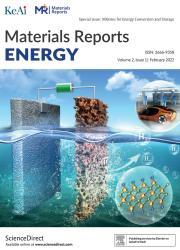WSe2纳米片的可调性质和通过能量依赖剥离的纳米分散
IF 13.8
引用次数: 0
摘要
过渡金属二硫族化合物(TMDs)是一种很有前途的电催化剂,可用于各种电催化过程。二硫化钼已被广泛应用,但一种电催化剂很难适用于所有的反应,这使得了解所选择的tmd的电化学性质至关重要。二硒化钨(WSe2)在气体演化过程中具有活性,与钼类似,但受到的关注有限。本研究探讨了不同的剥离力如何影响WSe2的结构构型及其对析氢、析氧和电容行为的催化性能的影响。研究了WSe2纳米片在液体(分散)相和固体(电极)相的结构特性。低剥落功率(90.4 W)有助于明确定义WSe2,而高剥落功率(814 W)导致硒空位数量增加。这些修饰会影响关键性能,如厚度、带隙(1.518至1.578 eV)、剥离率(0.27至0.12 mg mL−1)和氧化物含量(44.3%至53.9%),从而导致不同电解质中的不同电化学行为。高功率剥落的WSe2纳米片由于W-Se键的损失和非晶结构的形成,其析氢反应(HER)活性降低,但其析氧反应(OER)性能增强,特别是在碱性介质中。此外,由于质子的贡献,较高浓度的硒空位在酸性条件下提高了电容性能,但在中性和碱性电解质中则不太有利。这项研究强调了剥离功率在调整WSe2的结构特性以用于特定电化学应用中的重要性,促进了对其合成和性能的理解。本文章由计算机程序翻译,如有差异,请以英文原文为准。

Tunable properties of WSe2 nanosheets and nano-dispersion via energy dependent exfoliation
Transition metal dichalcogenides (TMDs) have emerged as promising electrocatalysts for various electrocatalytic processes. Molybdenum disulfide has been widely used, but a single electrocatalyst can hardly be applied to all reactions, making it essential to understand the electrochemistry of selected TMDs. Tungsten diselenide (WSe2) is reactive in gas evolution processes, similar to molybdenum, yet has received limited attention. This work explores how different exfoliation powers affect WSe2 structural configurations and their impact on catalytic performance in hydrogen evolution, oxygen evolution, and capacitive behaviour. The study investigates the structural properties of WSe2 nanosheets in both liquid (dispersion) and solid (electrode) phases. Low exfoliation power (90.4 W) contributes to well-defined WSe2, while higher power (814 W) leads to an increased number of selenium vacancies. These modifications influence key properties such as thickness, band gaps (1.518 to 1.578 eV), exfoliation yield (0.27 to 0.12 mg mL−1), and oxide content (44.3% to 53.9%), resulting in distinct electrochemical behaviours in different electrolytes. WSe2 nanosheets exfoliated at higher power exhibit reduced activity in the hydrogen evolution reaction (HER) due to the loss of W–Se bonds and the formation of an amorphous structure, but they show enhanced oxygen evolution reaction (OER) performance, particularly in alkaline media. Additionally, a higher concentration of selenium vacancies improves capacitive performance in acidic conditions due to proton contributions but are less favourable in neutral and basic electrolytes. This study highlights the importance of exfoliation power in tuning the structural properties of WSe2 for specific electrochemical applications, advancing the understanding of its synthesis and performance.
求助全文
通过发布文献求助,成功后即可免费获取论文全文。
去求助
来源期刊

材料导报:能源(英文)
Renewable Energy, Sustainability and the Environment, Nanotechnology
CiteScore
13.00
自引率
0.00%
发文量
0
审稿时长
50 days
 求助内容:
求助内容: 应助结果提醒方式:
应助结果提醒方式:


